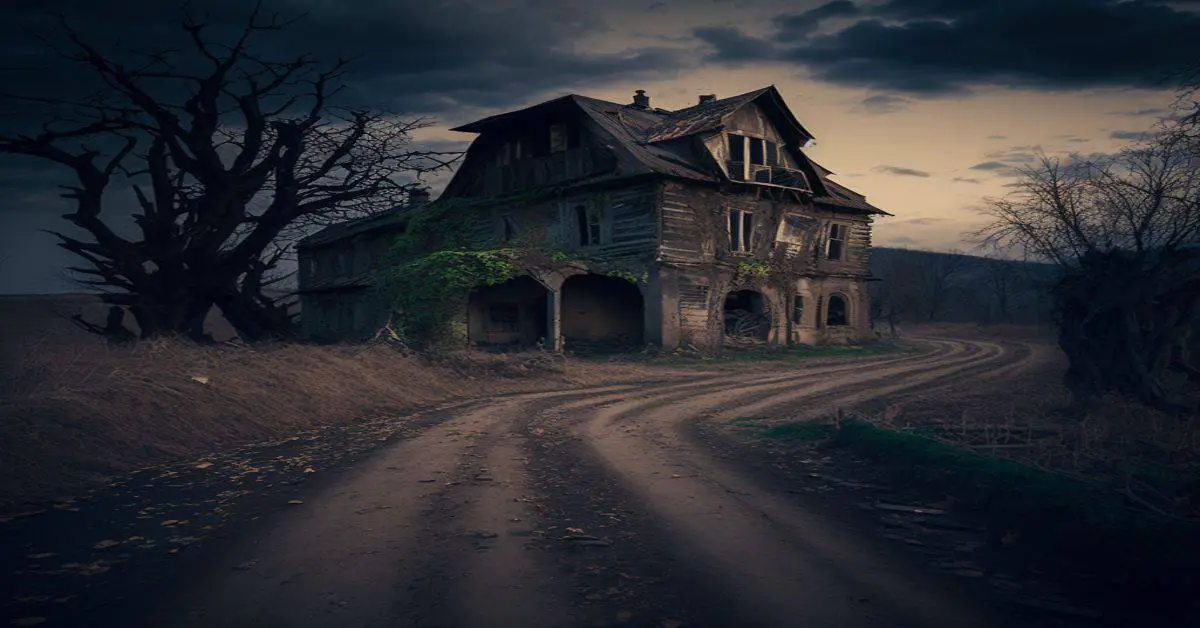You’ll find Crawfordsville, a vanished Illinois ghost town, 2.5 miles south of Flat Rock in Crawford County. This former mill town began with John Martin’s arrival in 1811 and Edward Allison’s water mill in 1830, but declined due to being bypassed by railroads. Today, no visible structures remain of this pioneer settlement, though archaeological findings reveal both prehistoric and early American artifacts. The town’s story reflects the challenging realities frontier settlers faced.
Key Takeaways
- Crawfordsville was a pioneer settlement in Crawford County, Illinois, located 2.5 miles south of Flat Rock along township boundaries.
- The town’s economic foundation centered around Edward Allison’s water mill established in 1830, but declined when railroads bypassed the community.
- Early settlers faced frontier challenges including harsh weather, agricultural difficulties, and the need to establish relations with Native Americans.
- The town’s gradual abandonment occurred during the early to mid-20th century due to economic challenges and better opportunities in nearby communities.
- No visible structures remain today, though archaeological findings reveal both prehistoric artifacts and pioneer-era settlement remains under cultural resource protection.
Location and Geographic Setting
Along the boundary between Montgomery and Honey Creek Townships in Crawford County, Illinois, lies the ghost town of Crawfordsville.
You’ll find this abandoned settlement approximately 2.5 miles south of Flat Rock in the southern portion of the state. The Crawfordsville geography reflects typical Midwestern terrain, with fertile soil that once supported local agriculture and milling operations.
A common settlement pattern in the 1800s led to many railroad towns developing in the region. Like its namesake in southeastern Iowa, this location represents one of several American towns sharing the Crawfordsville name.
The Crawfordsville climate follows the region’s pattern of seasonal extremes, featuring cold winters and warm summers.
The landscape surrounding the ghost town includes both prairie and forested areas, with local waterways that once powered the town’s mill operations.
The site sits within the Illinois Basin, where sedimentary rocks form the geological foundation of this historic settlement that time has nearly erased.
Early Settlement History
You’ll find that Crawfordsville’s first settlers faced typical frontier challenges of clearing wilderness and establishing relations with local Native American populations.
Much like the pioneers who founded Bethel Clay County, Crawfordsville attracted early settlers seeking new agricultural opportunities.
The town’s strategic positioning along the boundary between Montgomery and Honey Creek Townships influenced its early development patterns.
John Martin’s arrival in 1811 marked the beginning of permanent settlement in the area, setting the stage for his son H. Martin’s later industrial ventures.
In 1830, the establishment of a water mill by Edward Allison brought the first signs of industrial development to the growing settlement.
Pioneer Life Challenges
Life in early Crawfordsville tested pioneers’ resilience through extreme weather, hostile encounters, and agricultural hardships. You’d face scorching summers exceeding 120°F and brutal winters with life-threatening blizzards. Your survival strategies included building dugouts and makeshift shelters until you could construct proper log homes, using mud and wooden pegs in place of scarce hardware. Most settlers came from southern states, bringing their experience with frontier living and combat.
Your daily existence meant confronting raids from Sauk, Fox, and other Native American tribes, forcing you to seek protection in blockhouses like Whiteside Station. Pioneer women maintained continuous work schedules focused on household labor tasks.
You’d battle the stubborn prairie soil with limited tools while protecting crops from devastating grasshopper swarms. Nature’s unpredictability brought tornadoes, droughts, and powerful storms that could destroy your harvest in moments, making pioneer resilience essential for establishing a foothold in this unforgiving frontier.
Settlement Location Selection
Why did Edward Allison choose this particular spot for what would become Crawfordsville? The location’s proximity to a water source capable of powering his mill drove his settlement motivations in 1830.
You’ll find the site was strategically positioned between Flat Rock and Birds, making it an ideal hub for local agricultural trade and milling services. Similar to many place name conflicts, other Crawfordsville locations existed in different regions at the time.
The land acquisition straddled Honey Creek and Montgomery Townships, offering access to customers from multiple jurisdictions. While no major rivers ran through the area, a smaller creek or stream provided sufficient water power for Allison’s mill operations.
The relatively flat prairie terrain posed no obstacles to building or expansion, and the surrounding agricultural community guaranteed a steady stream of farmers needing milling services. Like many early Illinois settlements that became ghost towns, Crawfordsville’s fate was ultimately tied to changing economic and transportation patterns.
Disappearance and Abandonment
You’ll find that Crawfordsville’s decline stemmed from several critical factors, including its disadvantageous location between Flat Rock and Birds, plus its notable lack of railroad infrastructure.
The town’s heavy reliance on agriculture left it vulnerable to market fluctuations, while nearby communities offered more promising economic opportunities that drew residents away. Similar to towns like Buda, Illinois, where the population dropped drastically from a peak of 1500 to under 500 residents today.
Though the exact timeline remains unclear, the town’s abandonment likely occurred gradually through the early to mid-20th century, following patterns similar to other Illinois ghost towns of the era. Local author Christopher Hunt has since documented similar haunting tales in his book about Crawfordsville, Indiana’s ghosts, though these focus on a different municipality entirely.
Potential Causes of Decline
Multiple interconnected factors contributed to Crawfordsville’s eventual decline and abandonment, with economic challenges playing a particularly notable role.
You’ll find that railroad realignment notably impacted the town’s accessibility, while competition from larger nearby settlements drew away both businesses and residents. The town’s economic factors were further strained by shifts in agricultural practices and inadequate infrastructure to support modern development.
Environmental impacts also took their toll on Crawfordsville’s sustainability. Like many Illinois settlements, the town faced challenges from flooding and soil degradation, which affected farming productivity.
When combined with the broader migration to urban areas and lack of modern amenities, these conditions accelerated the community’s decline. Limited government support and changing demographics ultimately sealed Crawfordsville’s fate as residents sought better opportunities elsewhere.
Last Known Settlement Era
The final chapter of Crawfordsville’s existence remains shrouded in historical uncertainty, with no precise date marking its ultimate abandonment.
You’ll find no formal census records detailing Crawfordsville demographics during its decline, though evidence suggests the settlement gradually faded during the late 19th or early 20th century. The settlement architecture has completely vanished, leaving no visible remnants of the town’s final inhabited period.
What’s known is that Crawfordsville was likely a small hamlet situated between Flat Rock and Birds, straddling the boundary of Honey Creek and Montgomery Townships.
Unlike some Illinois ghost towns that disappeared due to natural disasters or railroad bypasses, you won’t find any documented catastrophic event that triggered Crawfordsville’s demise – it simply faded into obscurity.
Life in Early Crawfordsville
Life in early Crawfordsville centered around basic subsistence farming and simple rural living, as residents worked to establish their frontier settlement in Crawford County, Illinois.
You’d have found the community dynamics shaped by small-scale agriculture, with families growing their own food and raising livestock for survival. Daily routines revolved around tending crops, maintaining wooden homesteads, and gathering essential resources like water from local creeks and firewood from nearby woodlots.
If you’d lived in Crawfordsville, you wouldn’t have had access to formal institutions – there weren’t any schools, churches, or medical facilities in the settlement.
Instead, you’d have relied on neighboring communities for these services. Social interactions were intimate and informal, limited to family gatherings and occasional meetings with nearby settlers who shared your independent, self-sufficient lifestyle.
Transportation and Access Routes

Transportation in early Crawfordsville relied on a basic network of dirt roads and horse-drawn wagons connecting the settlement to nearby towns like Flat Rock and Birds.
The transportation evolution proved challenging as railroads bypassed the town, forcing residents to travel 2.5 miles to access rail service.
You’d find local commerce centered around water-powered mills, but access limitations eventually led to the town’s decline when the post office relocated to rail-connected Flat Rock.
- Your goods had to move by wagon over unpaved roads, slowing commerce to a crawl
- You couldn’t count on year-round travel due to seasonal flooding and poor road conditions
- Your town missed out on the railroad boom that transformed other Illinois communities
- You’d watch as neighboring towns with better transportation access grew while Crawfordsville shrank
- Your isolation deepened when major auto routes bypassed the settlement
Agricultural Heritage
Pioneer farmers Adam Ritchey and Matthew Moorhead established Crawfordsville’s agricultural foundation in the 1830s, setting up homesteads near Crooked Creek. You’d find them using basic tools like breaking plows and double shovels to work their modest five-acre plots, focusing primarily on sustenance farming. They’d supplement their harvests by gathering wild fruits like blackberries and grapes.
The region’s rich prairie soil and available timber supported the development of diverse farming techniques. As agriculture evolved, you’ll notice crop diversity expanded beyond basic grains to include vegetables, fruits, and hay.
Archaeological Findings

Although Crawfordsville’s modern landscape reveals little of its ancient past, archaeological excavations have unearthed significant prehistoric artifacts alongside early settlement remains.
You’ll find evidence of continuous human activity spanning from the Late Archaic period through early American settlement, with discoveries including stone tools, pottery shards, and historic bricks.
The site’s cultural significance is amplified by its connection to the broader Mississippian civilization that once dominated the Illinois-Indiana region.
- You can trace ancient food processing activities through nutshell-rich pit deposits
- You’ll discover diagnostic projectile points linking the site to regional Whale-Tail traditions
- You’re witnessing the shift from stone tools to industrial materials
- You’ll find evidence of sophisticated social structures through pottery remains
- You’re exploring layers of history from 1800 B.C. through the 19th century
Preservation Status
While Crawfordsville’s historical significance remains undisputed, its current preservation status reflects the challenges of protecting abandoned settlements.
You’ll find the town under Illinois’ Cultural Resource Protection program, which manages historical sites through digital submission and review processes.
The preservation challenges are significant, as the town has stood largely abandoned since the woolen mill’s closure in 1879.
While there’s potential for restoration of historical buildings and creation of educational programs, the remote location and deteriorating infrastructure make revitalization difficult without substantial investment.
Community engagement remains essential for any preservation efforts, though specific local initiatives aren’t currently documented.
You’ll notice that while the town isn’t listed on the National Register of Historic Places, such recognition could facilitate financial incentives for future preservation work.
Local Legends and Stories

Unlike many ghost towns that attract paranormal enthusiasts, Crawfordsville’s legacy lies not in supernatural tales but in its stark economic decline. You won’t find local folklore about ghostly whispers or haunted buildings here – the town’s story is one of mass exodus when the railroad chose a different path.
While other Midwestern ghost towns boast supernatural legends, Crawfordsville’s silence speaks only of abandoned dreams and economic necessity.
- Empty foundations stand as silent witnesses to families who once called this place home
- Roads leading nowhere remind you of the bustling streets that once connected a thriving community
- Railroad tracks that never came tell the story of prosperity that passed them by
- Missing buildings echo the sound of footsteps that walked away forever
- Forgotten pathways trace the route of those who sought better fortunes elsewhere
Frequently Asked Questions
Were Any Notable Crimes or Violent Incidents Reported in Crawfordsville?
You won’t find any documented notable crimes or violent incidents in Crawfordsville’s historical records. The limited surviving information about this small settlement doesn’t include reports of significant criminal activity.
Did Native American Tribes Have Settlements Near Crawfordsville Before European Arrival?
While there’s no evidence of permanent Native settlements near Crawfordsville, you’ll find that tribes likely used the area for seasonal hunting camps due to the marshy prairie’s abundant game resources.
What Natural Disasters, if Any, Affected Crawfordsville’s Development?
While you’d expect flood impacts around Honey Creek to have devastated the town, there’s no direct evidence of specific natural disasters, though regional storms and potential drought effects likely challenged development.
Were There Any Churches or Schools Established in Crawfordsville?
You won’t find evidence of Crawfordsville churches or Crawfordsville schools in historical records. While most Illinois settlements had these institutions, there’s no documentation confirming their existence in this small, short-lived community.
What Was the Peak Population of Crawfordsville Before Its Decline?
You’d think a town’s peak population would be easy to find, but there’s no verifiable historical record of Crawfordsville, Illinois, or its population decline. Historical significance remains unconfirmed.
References
- https://en.wikipedia.org/wiki/Crawfordsville
- https://www.heraldtimesonline.com/story/lifestyle/home-garden/2021/01/15/some-illinois-ghost-towns/43846097/
- https://www.youtube.com/watch?v=gM3ZIgtFzBk
- https://archive.org/download/historyofcrawfor00perr/historyofcrawfor00perr.pdf
- https://drloihjournal.blogspot.com/p/lost-towns-of-illinois-series.html
- https://legendsofkansas.com/crawford-county-extinct-towns/
- https://kids.kiddle.co/Crawfordsville
- https://en.wikipedia.org/wiki/List_of_ghost_towns_in_Illinois
- https://www.wikiwand.com/en/map/Crawfordsville
- https://drloihjournal.blogspot.com/2022/09/lost-towns-of-illinois-crawfordsville.html



